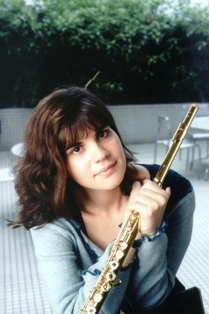
Flutist Bezaly Bows in with Mozart

Not a bad mix, Mozart and Bartok, both of which got special
treatment Friday morning at Music Hall.
Guest artist with Paavo Järvi and the
Cincinnati Symphony was flutist Sharon Bezaly, who put both artistry and
showmanship into Mozart's Concerto No. 2 in D Major and Andante in C Major,
K.315.
After intermission, Järvi and the CSO delivered a superlative
performance of the Bartok, finer even than their Telarc recording, if only
because it could be savored live in Music Hall.
Jarvi opened with a keenly
dramatic Overture to "Fidelio," an echo of last week's CSO season opener, which
featured music by Beethoven (and perhaps an afterglow as well to Järvi's cycle
of the complete Beethoven symphonies with the Deutsche Kammerphilharmonie Bremen
on tour this summer).
Israeli-born Bezaly (a resident of Sweden) grabbed a
mike as she walked onstage to introduce the Mozart Concerto. The cadenzas, she
explained, were by contemporary Finnish composer Kalevi Aho, not Mozart (whose
cadenzas for the concerto have been lost). A demonstrative player, she swayed to
the music during the orchestral sections, projecting both a warm, engaging
personality and a daunting technique.
Bezaly, 35, has mastered the skill of
"circular breathing" (inhaling into the lungs, then storing air in the mouth to
use as needed). This allows her to spin very long lines and lent an extra level
of expression to her performance. Aho's cadenzas spanned the flute register,
from low to very high, sometimes polevaulting in between. His music was quite
compatible with Mozart's and caused no stylistic "jarring."
Bezaly's 24-carat
gold Maramatsu flute (custom built for her) was beautifully matched to both the
concerto and the C Major Andante, a single movement work perhaps written for a
flute concerto Mozart did not complete. Coming after the concerto, it served as
a kind of built-in encore. The cadenza here, a lovely one by Mozart himself, was
a display piece on its own terms.
Bezaly, who has recorded Mozart's Flute
Concertos and his Andante for BIS, signed CDs for a long line of admirers at
intermission. (Unfortunately, her Mozart CD did not seem to be
available.)
Bartok's 1944 Concerto for Orchestra is the closest thing the
composer wrote to a symphony. Written on his death bed, it is full of
reminiscence and reflection. As a refugee from wartime Hungary, Bartok, who was
world famous as both a composer and a pianist (he performed the U.S. premiere of
his Piano Concerto No. 1 with the CSO under Fritz Reiner), spent his last five
years practically penniless and unknown in New York City. The Concerto, his most
popular work, is not merely a showpiece for orchestra but a repository of some
of his deepest feelings.
Järvi sought this dimension with the CSO Friday
while leading a performance drenched in color and corporate virtuosity. The
first movement, a solemn, almost creepy Andante followed by an aggressive
Allegro vivace, featured sonorous strings (gutsy violins on their lowest string)
and moments of stunning detail, such as the almost chamber music-like
interaction between oboe and harp. The CSO's new seating arrangement, with the
brasses along the back of the orchestra, allowed for clearer projection of
individual instruments and sections.
Percussionist Bill Platt set a frisky
tone on the drum for the second movement, "Game of Pairs," which featured pairs
of instruments sounding at fixed harmonic intervals. The frolicky bassoons drew
smiles, while the trumpets, muted and playing in seconds, felt like bee stings
amid the swirling strings.
The Elegia, keystone and emotive center of the
work, dripped with sorrow. Järvi crafted an ineffable moment near the end when a
faraway call by principal hornist Elizabeth Freimuth barely penetrated tremolo
shudders in the strings.
The Intermezzo interrotto ("Interrupted intermezzo")
was high hilarity tinged with bitterness as the famous quote from Shostakovich's
"Leningrad" Symphony broke in on the gorgeous viola theme (a hymn of Bartok's
native country). An extra layer of irony resides in the Russian composer having
based his theme on "Maxim's" from Lehar's "The Merry Widow," a favorite song of
Adolf Hitler.
The helter-skelter finale yielded the field back to the
strings, who after a brief respite, surged with the full orchestra towards the
almost painful fortissimo conclusion.
Repeat is 8 tonight at Music Hall.
(first published in The Cincinnati Post Sept. 22, 2007)